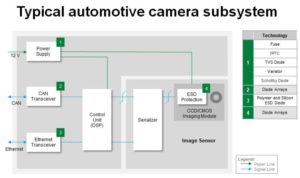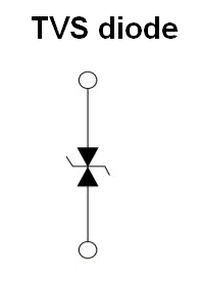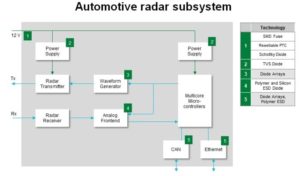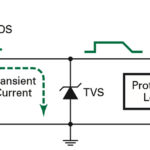The subsystems that make up an autonomous vehicle should be bullet-proof when it comes to electrical interference and transients.
James Colby, Prasad Tawade Littelfuse, Inc.
Those who follow autonomous vehicle technology are usually well aware of its benefits. But the safety and convenience autonomous vehicles offer can only come if the vehicle electronics is reliable and robust to electrical shocks such as lightning strikes (limited to the ac input of on-board chargers), in-vehicle power surges, and electrostatic discharge (ESD). Designers must incorporate circuit protection early enough in the design process to avoid last-minute revisions that can delay compliance approvals and potentially compromise circuit performance.

First consider the case of the camera subsystem. Among other things, multiple cameras work together to provide depth perception and convert visual light through a CCD/CMOS image sensor into electronic signals sent to a communication and control circuit. Of the circuit blocks in a camera subsystem, those that require protection components connect with external circuitry. They typically include a CAN transceiver, the power supply, and an Ethernet transceiver.
The camera power supply subsystem requires protection from over-currents, high-energy transients, and ESD. A fuse provides over-current protection. Designers can select either a conventional one-time blow, ceramic fuse, or a polymer-based, positive temperature coefficient (PPTC) resettable fuse. Both components can have wide temperature ratings for automotive requirements. Ceramic fuses can have operating temperature ratings of -55 to +150 °C, and PPTC resettable fuses can operate up to +125 °C. The PPTC has the advantage of not needing replacement if it experiences an over-current. The PPTC substantially boosts resistance in response to the heat generated by an over current. When the over-current is removed, the PPTC recovers to a low resistance. Both component types come in surface-mount packages to save valuable PCB space.

Besides over currents, power supply circuits need protection from high-energy transients caused by in-vehicle sources such as motors turning on and off. The circuitry must be capable of withstanding transients defined by ISO Standards 7637 and 16750. Compliant components include transient voltage suppressor (TVS) diodes which can safely absorb both low-energy transients and high-energy transients as specified in Pulses 1, 2, 3 and 5 that the above-referenced standards spell out.
Designers can also consider a metal oxide varistor (MOV) for transient energy protection. MOVs can absorb transients with surge currents of 500 A from 8×20-µsec pulses and up to 2.5 J from 10×1,000 µsec pulses. These components comply with Electromagnetic Compliance Standard IEC 61000-4-2. MOVs can also safely withstand the automotive environment with an operating temperature range of -40 to + 125°C.
To avoid catastrophic failure if the polarity of the voltage to the power supply accidentally reverses, designers can insert a Schottky diode in series with the fuse. While providing reverse polarity protection, the diode’s low forward voltage drop will have a minimal impact on power supply performance.

The Controller Area Network (CAN) protocol transceiver needs protection from ESD, fast electrical transients, and other over-voltage transients. Some diode arrays are specifically designed to protect the CAN lines without degrading. Diode arrays have high ESD tolerance with models having 30-kV air and 30-kV contact discharge capabilities. These devices help designers meet the ISO 10605 standard for ESD in road vehicles. As well as withstanding the high ESD voltages, the diode arrays can absorb up to 50 A of transients defined by IEC Standard 61000-4-4 (Electrical Fast Transients). Furthermore, with a capacitance of about 15 pF and leakage current under 1 µA, the diode arrays do not interfere with protocol transmissions.
These devices also survive the automotive environment with a temperature operating range of -40 to 150°C. Circuits designed to protect a CAN transceiver generally include a two-channel diode array on both the high and low lines. A single protection component containing both arrays is available and helps to reduce pick-and-place costs in production.

The Ethernet transceiver, like the CAN transceiver, needs ESD and transient surge protection. Diode arrays and polymer ESD suppressors can provide the necessary protection for the high-speed differential data lines. Models of these diode arrays can provide up to ±30 kV ESD protection and can absorb up to 50 A of Electrical Fast Transients.
Diode arrays can protect a differential line pair in a single package to save space. Versions are also available as discrete components in 0402 and 0603 surface mount packages to minimize capacitance and PCB space. These ESD protection devices cut signal distortion, reduce voltage overshoot, and simplify the circuit design. Capacitance values can get down to 0.35 pF for the diode array and down to 0.04 pF for the polymer ESD suppressor. These parameters ensure the ESD protection does not impede 1-Gbit Ethernet transmission rates.
The most important circuit block is that of the image sensor. A single pair, bipolar set of ESD diodes can protect the image sensor and its circuit. The diodes in this bipolar protection component are oriented cathode to cathode. This model of TVS diode can withstand an ESD strike of up to ±30 kV and has extremely low leakage current with typical values of under 10 nA. Its capacitance is around 0.35 pF. These TVS diode arrays have ultra-small, 1.0×0.5-mm SOD882 packaging to minimize board space. Keeping protection components as close as possible to the circuit inputs keeps extraneous energy from damaging critical parts.

The radar subsystem provides the input for forward and side pedestrian detection and collision avoidance. The circuit generally has two dc power supplies, a low-noise supply powering the analog radar transmitter and receiver circuit blocks, a conventional supply for the logic and communication circuits. Like the camera subsystem power supply, radar subsystem power supplies need over-current protection, transient surge protection, reverse polarity, and ESD protection.
One set of protection components can handle over currents and reverse polarity for both supplies. Again, designers can employ either a conventional surface-mount fuse or a PPTC resettable fuse. A low-forward-voltage Schottky diode, in series with the input line to both supplies, will protect against reverse polarity for both power supplies and the radar subsystem circuit blocks. Designers should provide each supply with surge protection at the input.
TVS diodes are the recommended surge protection component. They can absorb large amounts of transient power, such as 600 W for 1 msec. These diodes can also absorb up to 100 A of transient current. Designers select a TVS diode based on its transient power rating (400/600 W for low-power transients and 1,500/7,000 W for high-power transients).
The waveform generator and the analog front end are part of the radar transmitter and radar receiver, respectively. They are separate from the transmitter and receiver blocks because protection components on the transmitter output and receiver input blocks would alter their transmission and reception impedance. The protection components safeguard as much of the circuits as possible. A bipolar diode array is the recommended component for ESD protection. A component similar to the diode array protecting the image sensor in the camera subsystem will provide the necessary ESD protection. The high-sensitivity analog front end requires ESD protection that will not interfere with the circuit’s low-level signal integrity. Designers should consider a bipolar polymer ESD suppressor. The ESD suppressor has a capacitance below 0.1 pF and draws under 1 nA of leakage current for a minimal impact on the circuit’s gain and bandwidth.
As with the camera subsystem, the radar subsystem sends its information to the vehicle central processing subsystem. Bipolar diode arrays provide ESD protection for both the high and low side of CAN I/O lines. The Ethernet transceiver can use either diode arrays or polymer ESD suppressors to minimize signal distortion and not impact the Ethernet transmission rate.
The radar system is crucial for the safe, proper operation of an autonomous vehicle. It is, like the camera system, the set of eyes that monitor the road. Protection of its circuit blocks from the external environment is essential.
Protecting the ADAS
The signal processing, communication, and control subsystem operates the vehicle. This main subsystem must be robust, reliable, and fail-safe. The circuit must react to other vehicles in traffic and make fast stops when an animal or person obstructs the vehicle’s path, And the subsystem must have a fail-safe response to a failed sensor. All circuit blocks that supply information to the controller need protection from ESD.

The ADAS power supply, like the other power supply blocks, requires over-current protection, surge protection, and reverse polarity protection. The fuse for this supply can reside within the module or further upstream in the vehicle’s low-voltage junction box. A TVS diode, picked for its surge power rating, protects against surge transients. A Schottky diode in series with the power supply input line provides reverse voltage polarity protection.
Each communication link requires ESD and transient protection designed for each port’s performance and configuration. Designers can select from a wide range of diode arrays and polymer ESD suppressors that can protect each communication link without compromising its data rate or its high-to-low voltage differential.
Any signal lines connecting directly to the DSP circuit block should have ESD and transient protection. Designers can use diode arrays or polymer ESD suppressors that provide bipolar protection for both the high and low signal lines.
The ADAS communication and control subsystem is the primary intelligence for autonomous vehicles. It’s critical that this subsystem remains operational at all times. ESD protection on all ADAS inputs and outputs will protect the subsystem from disabling ESD strikes, and TVS diodes will protect against surge transients generated by electric and electromechanical devices.

Designers should be aware of the ISO standards with which vehicle electronic systems must comply. The most important of them include Standard ISO7637-2, which defines requirements for protection from conducted electrical transients; Standard ISO16750-2, which describes environmental stresses that automotive electrical and electronic systems must withstand; and Standard ISO 10605:2008, which defines the ESD conditions that automotive electronics must withstand. Familiarity with these standards helps designers avoid expensive and time-consuming re-designs.
The automotive industry has defined a qualification system for components that can be used in automotive electronic circuits. The components that pass a set of defined mechanical, electrical and environmental stress tests, including operation over a wide temperature range, can be designated as AEC-Q (Automotive Electronics Council-Quality). There are a number of “Q” values, including AEC-Q100, AEC-Q101, and AEC-Q200. This qualification system determines which tests must take place. Use of AEC-Q qualified components can enable a faster approval process for automotive electronic circuitry.
To certify a component as Automotive Grade, a manufacturer generally must do more than prove a component passes a series of defined tests. The manufacturer should also have a documented Production Part Approval Process (PPAP) which demonstrates the supplier can manufacture the components to consistently meet its quality requirements at a specified production rate. And the manufacturing facility should be certified to International Automotive Task Force (IATF) 61949; an automotive quality system based on ISO 9001.
In a nutshell, robust, reliable vehicle electronic systems will help to make autonomous vehicles fixtures on the road. Designers can substantially reduce the risk of circuit failures by providing over-current protection, transient surge protection, ESD protection, and reverse polarity protection.
References
The article, Advanced Circuit Protection for Connected Autonomous Vehicles, presents protection solutions for vehicle electronic circuits not mentioned here, https://www.powerelectronictips.com/advanced-circuit-protection-for-connected-autonomous-vehicles/
For more information on protection of automotive circuits, see the Littelfuse Automotive Electronics Applications Guide, littelfuse.com/automotive-electronics-applications-guide







Leave a Reply